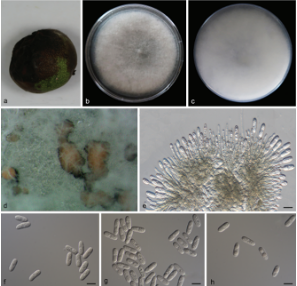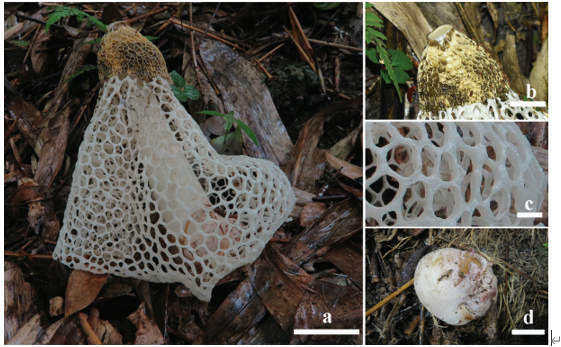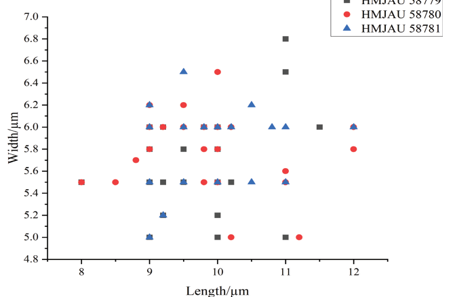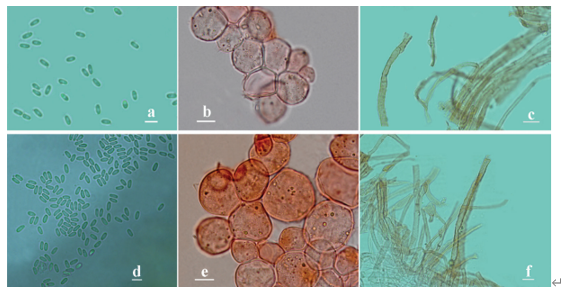Parvosmorbus guangdongensis W. Wang & S.F. Chen 2020
MycoBank MB832457
Holotype: China, GuangDong Province, ZhanJiang Region, SuiXi county, LingBei Town (N21°16'00.960" E110°05'32.690"), from the stem bark of the E. urophylla hybrid genotype, 28 July 2016, S. Chen & W. Wang, CSFF2050 (holotype HMAS290464, ex-type culture CSF10460 = CGMCC3.19514).
Morphological description
No ascostromata were observed on the Eucalyptus bark collected from the plantations or on the inoculated Eucalyptus branch tissue. Conidiomata pycnidial, superficial to slightly immersed, solitary, conical to globose without necks, bright yellow when young, fuscous black when mature. Conidiomatal base 133–556 µm (av. 280 µm) high above the level of the bark and 66–420 µm (av. 150 µm) wide. Conidiomatal locules unilocular, locules 76–223 µm (av. 135 µm) diam. Stromatic tissue textura porrecta. Conidiophores hyaline, branched irregularly at the base or above into cylindrical cells, with or without separating septa, (5–)9–9.5(–31) µm (av. 9.2 µm) long. Conidiogenous cells phialidic, cylindrical with or without attenuated apices, (1–)2 µm (av. 1.8 µm) wide. Paraphyses or cylindrical sterile cells absent. Conidia hyaline, aseptate, oblong to fusoid, occasionally allantoid, exuded through an opening at the stromatal surface as orange droplets, (3–)3.5(–4.5) × (1–)1.5 µm (av. 3.6 × 1.4 µm).
Culture characteristics — Colonies on MEA fluffy with an uneven margin, white when young, turning yellowish white after 10 d. Colony reverse white to yellowish white. Optimal growth temperature 30 °C, no growth at 5 °C. After 7 d, the colonies
at 10 °C, 15 °C, 20 °C, 25 °C, 30 °C, and 35 °C had reached 14, 15, 29, 46, 53, and 24 mm, respectively.
Substrate — Bark of E. urophylla hybrid genotype and E. grandis hybrid genotype.
Habitat: From the stem bark of the E. urophylla hybrid genotype.
Distribution: GuangDong Province, China.
GenBank Accession: ITS: MN258799; tub2: MN258813; tub1: MN258827; tef1: MN258841; LSU: MN258855
Notes: Parvosmorbus guangdongensis is morphologically similar to Par. eucalypti, but the conidia of Par. eucalypti (av. 3.9×1.4 µm) are slightly larger than those of Par. guangdongensis (av. 3.6 × 1.4 µm). Parvosmorbus guangdongensis differs from Par. eucalypti by uniquely fixed DNA nucleotides in three nuclear loci, ITS (ITS1, 5.8S, ITS2) positions 124 (C), 279 (A), 280 (A), 281 (A), 282 (A), and 283 (A); tub2 positions 145 (G) and 146 (G); tub1 positions 139 (T), 140 (G), and 150 (T).
Reference: W. Wang[1],2, G.Q. Li1, Q.L. Liu1 et al.

Asexual sporocarps of Parvosmorbus guangdongensis. a. Black conidiomata with an orange conidial spore mass; b– c. longitudinal section through conidioma showing unilocular stroma; d. textura porrecta stromatic tissue of the conidioma; e–f. aseptate, cylindrical conidiophores and cylindrical conidiogenous cells; g. fusoid to oval, aseptate conidia; h–i. living cultures after growing 7 d on MEA at 25 °C, (h) front, (i) reverse. — Scale bars: a = 100 µm; b– c = 50 µm; d = 10 µm; e–g = 5 µm; h–i = 10 mm.









